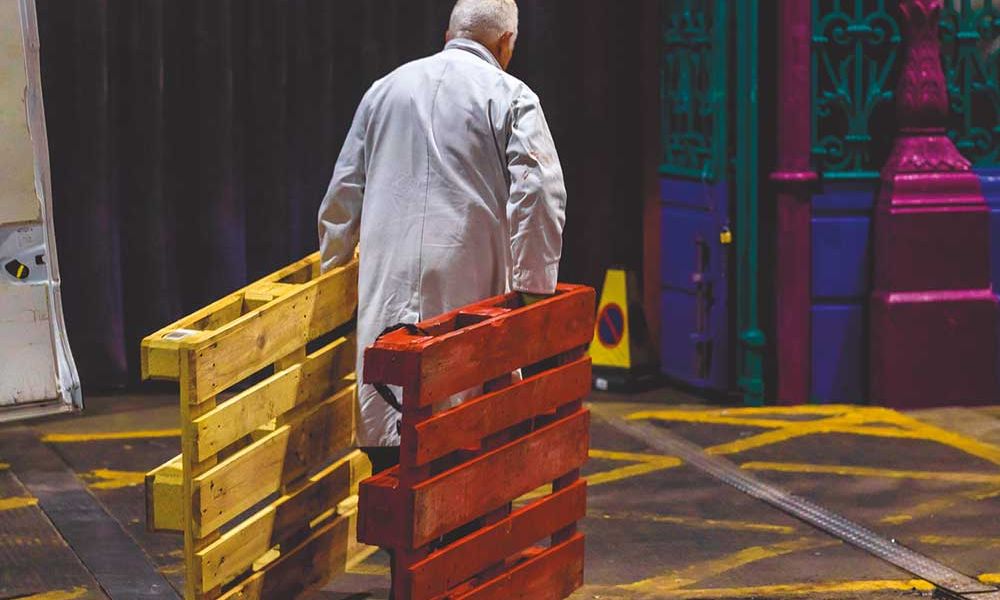A worker at the London Central Markets, the largest wholesale meat market in Europe, which occupies the eastern end of the Smithfield site. Smithfield will house, at its western end, the new Museum of London, in long-derelict 19th-century former market buildings Shane Aurousseau/Alamy Stock Photo
Museums have become better at recognising the nuances of race, sexuality and gender, but still struggle to confront issues surrounding class divides. So says a new investigation undertaken by Museum of London, working in collaboration with King’s College London’s Department of Culture, Media and Creative Industries, which launched at a conference in January at the Museum of London’s Docklands site. The museum’s new central London site is due to open in 2026 on the refurbished western end of Smithfield market, a historic meeting point of working class labour.
The findings of the investigation are published in a report titled Museums, Class and the Pandemic. The 64-page report, which is available online, includes oral histories from a sample of 15 working-class participants, each of whom are interviewed about their experiences of living and working in London. The report focuses in particular on frontline labour during the Covid-19 pandemic, throughout which much of the investigation’s research was compiled.
The research began, the report states, with two key goals: to document the stories of working-class Londoners during the pandemic, and to learn from that process how museums can better serve working-class communities, both in terms of workforce representation and in collections and displays. The report does not analyse museum audiences.
Domenico Sergi, a senior curator at the Museum of London with an extensive background in anthropological and ethnographic research, wrote the report with Serena Iervolino, a lecturer in arts and cultural management at King’s College and the vice-chair of International Council of Museum’s (Icom) International Committee for Museums and Collections of Ethnography (ICME).
Sergi tells The Art Newspaper that the research seeks to address social inequality and class divisions, sharpened during the Covid-19 pandemic, “by focusing on working-class Londoners such as supermarket cashiers and delivery drivers, who were essential, albeit less celebrated, than others to the running of the city”. The research was funded by Arts Council England—which announced it would begin analysing socio-economic diversity in the culture workforce for the first time in 2020-21.
“Over the last decades, socioeconomic differences have largely been disregarded by museums, and class has been overlooked,” Sergi says. “This report wants to shift the debate, emphasising the intersectional nature of class.”
A rendering of the new London Museum, which is due to open in 2026
© Asif Khan Studio
Among the participants who were interviewed for the study was John, who during the pandemic, worked as a food delivery courier. Couriers were among the few essential workers to continue to work on the frontline during lockdowns, but John recounts facing contemptuous attitudes from some of the people he delivered to. “As a courier, you’re treated as a lower individual, or someone from a lower society,” he says.
But John’s experiences as a courier are not all negative. He also speaks of a “really good sense of community among the courier ecosystem”.
The research documents plenty of evidence of hardship, vulnerability and discrimination, but is also interwoven with stories of solidarity and community. The report tries to counterbalance “a pervasive rhetoric of poverty and struggle” when presenting the lives of the working classes.
The report evokes the specific challenges of a sample of working-class Londoners, but it also touches on how complex it is to define “working class” today, given the identity-based nature of socio-economic status. A 2021 study by Sam Friedman, a professor of sociology at the London School of Economics, also demonstrated how unusual Britain’s perspective on class is, with a tendency to downplay privilege: 47% of Britons with professional and managerial jobs identify as working class.
The Museums, Class and the Pandemic study focuses on low-paid employment, using this as a marker of what defines working class, and excluding those who might work in middle-class jobs but come from working-class backgrounds.
Michelle McGrath is the founder of Museum as Muck, a support network of museum, gallery and heritage employees from working-class backgrounds. Museum as Muck also advocates for change in the socio-economic diversity of the sector’s workforce and explores class-conscious approaches to interpretation, programming and collecting.
When McGrath began her career as a museum professional, she found herself seeking out other people in the sector, who, like her, came from a working-class background—Museum as Muck grew organically into a more formal organisation in 2018 and now counts more than 800 members. It is one of the key organisations mentioned in the report.
In an afterword that McGrath contributes to the report, she writes that “the class conversation was lacking in museums until recently” concluding that “class pervades all aspects of our society so it should be included and documented in the same way in our museums.”
The report concludes with a set of clear recommendations for museums for the future —calling on the sector to better understand its civic role and public function to serve everyone in society. These include the need for a “networked approach”, partnering with universities, for example, to attract and retain working-class museum staff.
The authors also point to the importance of a proactive approach to recording nuanced working-class narratives—citing a lack of visual and material culture that represents working class lives. These should be preserved in museum collections, the report says.
The report seeks to break the continuing silence around class. But it also poses broader questions—as Sergi and Iervolino concede, the report “only begins to scratch the surface of the work that museums need to undertake in order to better care for and represent working-class communities”.

